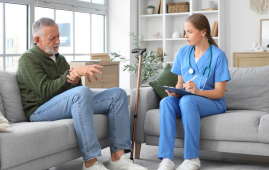

Have you ever made a spectacular catch, such as saving a phone from a toilet or catching an indoor cat from fleeing outside? Those abilities, such as the ability to grasp a moving object, necessitate precise interactions inside and between our visual and motor systems. Researchers at the University of Rochester’s Del Monte Institute for Neuroscience discovered that the capacity to visually foresee movement may be a crucial aspect of making successful eye-hand coordination resulting catch—or grabbing a moving object.
“We were able to develop a method that allowed us to analyze behaviors in a natural environment with high precision, which is important because, as we showed, behavioral patterns differ in a controlled setting,” said Kuan Hong Wang, Ph.D., a Dean’s Professor of Neuroscience at the University of Rochester Medical Center.
Wang led the study, which was published today in Current Biology in collaboration with Jude Mitchell, Ph.D., assistant professor of Brain and Cognitive Sciences at the University of Rochester, and Luke Shaw, a graduate student in the Neuroscience Graduate Program at the University of Rochester School of Medicine & Dentistry. “Understanding how natural behaviors work will provide us with a better understanding of what is wrong in a variety of neurological disorders.”
Researchers recorded where the primate is looking as well as the movement of the arm and hand as it reaches and catches moving crickets using numerous high-speed cameras and DeepLabCut—an AI technology that leverages video data to pinpoint important areas on the hand and arm to measure movements. The researchers discovered an 80-millisecond delay in the animal’s visuomotor behavior—the instant when vision and movement sync up to drive the hand toward the target.
Despite the measured delay, the primates caught the crickets, implying that they had to anticipate the cricket’s movement. The researchers were able to develop a thorough model of vision directed reaching behavior using data from both monkeys and crickets.
“These findings allow us to identify unique behavioral control strategies for mechanistic studies and engineering applications,” said Wang. “Visuomotor control problems exist in many neurological disorders due to brain lesions, stroke, and genetic factors. This research may help develop computational behavior analysis strategies to precisely characterize behavioral alterations in naturalistic settings and understand their underlying causes.”
more recommended stories
 How the Uterus Senses Force During Labor: New Insights
How the Uterus Senses Force During Labor: New InsightsA new study published in Science.
 Fat-Free Mass and Brain Outcomes in Preterm Babies
Fat-Free Mass and Brain Outcomes in Preterm BabiesEarly Fat-Free Mass May Hold the.
 How Hormones Shape Dopamine-Driven Learning
How Hormones Shape Dopamine-Driven LearningNYU Study on Hormones and Cognitive.
 Protein Pair Guides Chromosome Alignment in Mitosis
Protein Pair Guides Chromosome Alignment in MitosisKey Points A joint research team.
 Intensive mind-body retreat rapidly alters brain function
Intensive mind-body retreat rapidly alters brain functionAn intensive mind-body retreat combining meditation,.
 Citrus and Grape Compounds Help Prevent Type 2 Diabetes
Citrus and Grape Compounds Help Prevent Type 2 DiabetesA new clinical trial highlights the.
 Personalized Pain Care Transforms Parkinson’s Treatment
Personalized Pain Care Transforms Parkinson’s TreatmentNew UniSA research underscores the urgent.
 Genetic Diversity Explains Obesity Risk Differences
Genetic Diversity Explains Obesity Risk DifferencesCross-ancestry Study Identifies Novel Obesity Genes.
 Meniscal Tear and OA Pain Improved by Home Exercise
Meniscal Tear and OA Pain Improved by Home ExerciseHome Exercise Proves Effective for Knee.
 AI ECG Model Outperforms Standard STEMI Triage
AI ECG Model Outperforms Standard STEMI TriageNovel AI ECG Model Outperforms Standard.

Leave a Comment